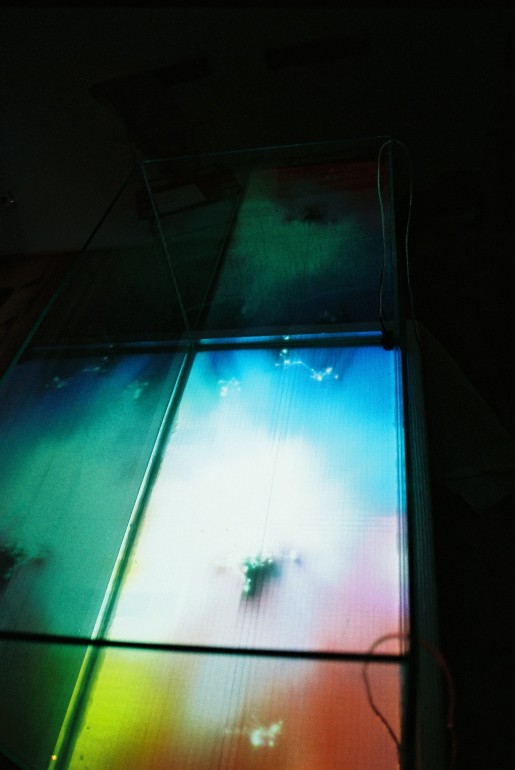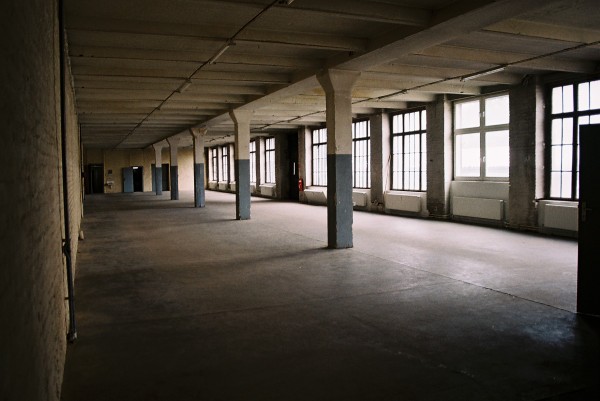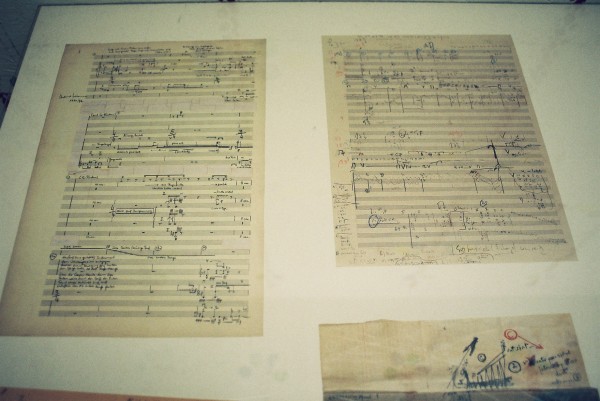Earlier this month I headed to Berlin to check out S.LOW Projekt, an interdisciplinary art project spanning the summer months organised by my masters supervisor Ricardo Climent. While I was there I got to see the latest incarnation of Sam Salem and Patrick Sanan’s Pond Life series, exhibited at Projektraum Schwarz in the gallery-studded area Neukölln. This is an audiovisual work featuring a tank of water as a projection surface and two hydrophones that provide the generative software behind the work with a rough estimate of where any agitation in the water is. This means people can splash about and affect the small neon creatures that appear to be inhabiting the tank. Here is an inadequate photograph from the installation, but check out Sam & Patrick’s websites for videos and more information:
The great thing for artists in Berlin appears to be the wealth of cheap space to work in, much of it in old industrial buildings. One strand of the S.LOW programme took place at N.K., a sound-art community on two floors of a disused factory that has half a dozen studios and an empty floor for larger events that looks wonderfully broody when deserted:
Probably the most incredible thing I saw in Berlin was Innen Stadt Außen, an exhibition of works by Danish-Icelandic artist Olafur Eliasson at the Martin-Gropius-Bau. If you have heard of Eliasson, it is probably because it was he who put the enormous sun in the Turbine Hall at Tate Modern. I remember thinking at the time that I couldn’t understand what the fuss was about (not being able to visit it myself) — it was just a big sun, wasn’t it? That’s the kind of reaction I�������������ve had when trying to explain the works at Innen Stadt Außen to people, breathlessly, urgently, because it was awesome. And I use that word in full understanding of its origins. No cameras were allowed in and the exhibition website is woefully inadequate, but pictures probably wouldn’t convey the experience anyway. Try this description: there was an incredible 10-minute piece of video-art which featured a white van with an enormous mirror strapped to its side driving round Berlin. Doesn’t really spark the imagination, does it? In short the problem with words here is that all the ideas were of extreme simplicity, description belies their impact, but their execution was consistently breathtaking. Trust me, if ever this man does anything near you. Go.
Perhaps it’s worth noting that — despite the clearly touristy, visiting ‘events’ aspect of this post — Berlin is a truly great place to hang out. Having rushed headlong into sightseeing, felt my legs grow tired and lose all sense of time and location in the Jewish Museum (which is, by the way, an excellent building), I discovered that the bars and cafés of Kreuzberg and Neukölln were quite spectacularly laid back and that my sandwich came with a salad with kumquats and cranberries!!!
A good exhibition I could take photos of was FischGrätenMelkStand curated by German artist John Bock at the Temporäre Kunsthalle Berlin, which contained a collage-like amalgamation of artworks built into a large scaffolding maze. Here are some half-built houses, which were tangled in the web of artworks:
There are a few more photos from this exhibition and N.K. on my (brand-new) Flickr page, but one last thing to share here is something that is infinitely geeky, but exciting for me. As some may know, I’m a bit of a Helmut Lachenmann obsessive and here, in this maze of contemporary art and extremely stale pizzas, in a small glass case, were two pages, on loan from the Paul Sacher Stiftung, of manuscript sketches from the great man himself. Perhaps it was just their incongruence in the tangle of art, but it seemed slightly thrilling. Though visually unspectacular here they are:




